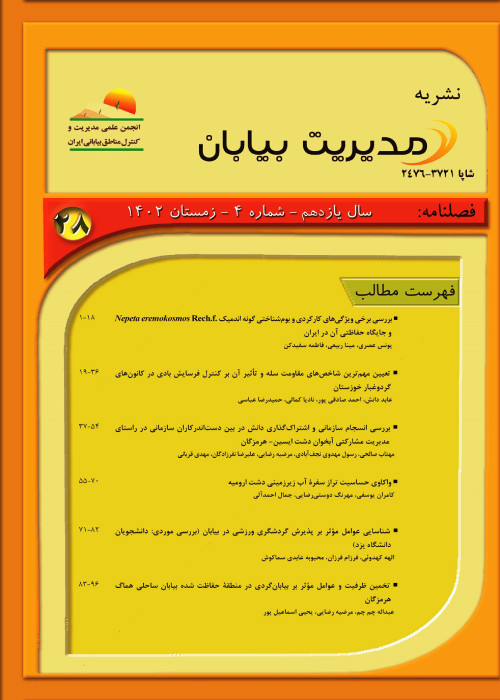Investigating the Vegetation Characteristics of Plant Species That Are Compatible with Protecting Marl Soil in Kashan
Marl formations are one of the most important sources of sediment production in arid and semi-arid regions. Marl lands are highly susceptible to erosion, causing an increase in drinking water treatment costs, reducing the useful life of dams, and significantly decreasing the permeability of floodwater spreading areas. Different forms of erosion have been shown to have a relationship with the geological characteristics of marls, as evidenced by research. The results of the study of the effect of the physical and chemical properties of marl sediments on erosion in Latshore-Pakdasht showed that the amount of Na+, SO4-2 and silt in the marl lands increased, while the percentage of clay decreased from surface to gully erosion. The form and intensity of water erosion are greatly influenced by changes in soil texture. Gully erosion can be developed by increasing the amount of sand compared to the finer particles of silt and clay. Despite the difficulty of vegetation establishment on marl lands, in some areas, surprisingly, a relatively dense cover of rangeland species can be observed, which can cause erosion control and soil stability. The results of the systematic survey of plant species and their protective role in the marl lands of Ilam, Yazd and Gilan provinces all indicate that rangeland species are one of the most effective and suitable methods to prevent soil erosion by creating a stable vegetation cover on marl formations. The relationship between the physical and chemical properties of the soil with vegetation characteristics including distribution, canopy cover and density is inevitable. In the marl lands of Borujen, the research revealed that vegetation type named Astragalus brachycalyx-Daphne mucronata-Cirsium bracteosum can be established in neutral marl lands, with medium CaCO3 content and minimal presence of Na+ and Cl-. On the other hand, the vegetation type named Astragalus susianus-Daphne mucronata-Amygdalus elaeagnifolia can be established in alkaline and calcareous marl lands with very high amounts of Cl- and can be effective in controlling water erosion in marl lands. Considering arid and desert climate and the occurrence of surface, rill and gully erosions in the marl lands of Kashan region, as well as the importance of protecting and controlling erosion in the marl formations of the region and the lack of detailed vegetation studies in this region, accurate identification of the vegetation of the marl lands and prioritizing native and resistant plant species is necessary for the rehabilitation management of vegetation and biological protection of soil in these areas. Therefore, the aim of the current research is to identify rangeland species and investigate their role in erosion control in the selected marl formations in Kashan. In addition, the physical and chemical soil parameters of marl lands and the vegetation characteristics of plant species in different types of erosion are investigated.
Kashan is one of the marl regions chosen for the current study on the classification and determination of marl erodibility indices in Isfahan province. Two vegetation types named Anabasis setifera-Artemisia sieberi-Salsola tomentosa and Pteropyrum aucheri-Pteropyrum olivieri-Artemisia sieberi have been identified in the selected Marl lands of Kashan. In order to evaluate the erosion condition in three erosion forms of surface, rill and gully, BLM (Bureau of Land Management) form was completed in the same marl units and control areas without vegetation cover. In the next step, three soil samples were collected from 0-20 cm depth in three repetitions in marl units including three forms of erosion. The physical and chemical soil properties including texture, EC, N, P, SAR, OC, CEC, CaSO4 and CaCO3 were measured. For vegetation studies in the study area, after preparing the floristic list of plant species, three 100 m transects were established in a random-systematic method. In each transect 10 plots of 2 m2 were placed and vegetation characteristics including canopy cover percentage and density per plant species, as well as the percentage of gravel and litter were measured and recorded. The statistical analysis of the data was done as a completely random design using SAS software, and the averages of soil properties were compared according to the Least Significant Difference (LSD). Correlation analysis between soil and vegetation characteristics was done by SPSS statistical software.
The results showed that in terms of erodibility, Marl lands with vegetation cover had a better condition than those without vegetation. Based on analysis of variance, the physical and chemical parameters of soil and vegetation characteristics in three types of erosion had significant differences at level of 1% and 5%. In gully erosion, the amount of N, P, SAR, OC, litter and canopy cover were in better conditions compared to other types of erosion. The results of correlation between soil properties and vegetation characteristics showed that the canopy cover had significant correlation with the percentage of sand (r=0.92) and a negative correlation with the amount of CaCO3 at (r=0.97). In terms of the type of dominant plant species, in surface erosion Ephedra strobilacea Bunge. with canopy cover of 1.71%, in rill erosion Anabaisis setifera Moq. with canopy cover of 1.24% and in gully erosion Artemisia sieberi Besser. with canopy cover of 12.3% were identified as the most suitable species for soil protection. In all three types of erosion, bushes had the highest percentage of density in terms of growth form. In surface erosion and gully erosion, shrubs occupied the highest percentage of canopy cover. In gully erosion, due to better conditions of soil moisture and organic matter, bushes and shrubs were successful in competition with annual and herbaceous plants. They established well due to deep and extensive root system. The results of current research could be considered as a novel achievement in order to prevent soil erosion through establish appropriate species in marl lands with similar climatic conditions.
- حق عضویت دریافتی صرف حمایت از نشریات عضو و نگهداری، تکمیل و توسعه مگیران میشود.
- پرداخت حق اشتراک و دانلود مقالات اجازه بازنشر آن در سایر رسانههای چاپی و دیجیتال را به کاربر نمیدهد.


